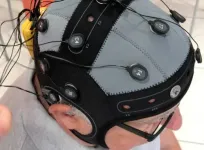(Press-News.org) A study from the Center for Phage Technology, part of Texas A&M's College of Agriculture and Life Sciences and Texas A&M AgriLife Research, shows how the "hidden" genes in bacteriophages -- types of viruses that infect and destroy bacteria -- may be key to the development of a new class of antibiotics for human health.
The study has been published in Nature Communications and Current Science Daily, as well as featured in a recent Nature Research Microbiology Community blog post.
The need for new antibiotics
Antibiotic-resistant bacteria pose an increasing threat to human health, creating an urgent need for the development of novel antibiotics.
"There has been an increased interest in bacteriophages and their potential as antibacterial agents to fight pathogenic bacteria," said Center for Phage Technology director Ryland Young, Ph.D., who supervised the study research. "This is in large part due to the ability of the 'lysis genes' of the phage to cause a cellular breakdown in the bacterial host."
Gloved lab worker
The need for new and more effective antibiotics has increased interest in bacteriophages as possible agents to fight pathogenic bacteria.
Most phages can cause their host cell to rupture, a process called lysis. They also release new "progeny" phage virions that are genetically and structurally identical to the parent virus.
"Small phages, such as the ones this study focuses on, make a single protein which causes host lysis," Young said. "Basically, the virus produces a 'protein antibiotic' that causes lysis in the same way antibiotics like penicillin do - by disrupting the multistage process of cell wall biosynthesis. When the infected cell tries to divide, it blows up because it can't create the new cell wall between the daughter cells."
He said these small lysis proteins can be the model for a completely new class of antibiotics.
Purpose and key findings of the study
The study focuses on characterizing the lysis genes of leviviruses, bacteriophages containing small single-stranded RNA genomes with only three to four genes. Tens of thousands of leviviruses have been discovered. Among the known levivirus genes is Sgl, which stands for 'single gene lysis.' Sgl encodes a protein that induces the cellular breakdown of bacteria.
Many leviviruses contain Sgl genes, but these have remained "hidden" from researchers as they are small, extremely varied and can be embedded within other genes.
"We wanted to discover these 'hidden' lysis genes in single-stranded RNA phages, as well as understand how their structure and evolution could benefit development of new, more effective antibiotics," said Karthik Chamakura, Ph.D., a postdoctoral research associate at the center and the study's first author. "We also wanted to investigate how certain molecular targets within bacteria could be identified and exploited for antibiotic development."
Dr. Karthik Chamakura in lab at Center for Phage Technology finding new sources of antibiotics
Karthik Chamakura, Ph.D., postdoctoral research associate with the Center for Phage Technology at Texas A&M University, was the study's first author. (Texas A&M AgriLife photo)
In this study, researchers were able to identify 35 unique Sgls that produced a lytic or destructive effect on E. coli bacteria, Chamakura said. The team also determined that each of these Sgls could potentially represent a distinct mechanism for the lysis of host cells.
Chamakura also noted previous research had shown that known single-stranded RNA phages have high mutation rates.
"High mutation rates allow these phages to infect new species of bacteria," he explained. "In order to escape the new hosts, the phages have to either change the existing Sgl gene or evolve a new Sgl. In spite of a very short total length of genomic RNA, these phages can encode two or more Sgls or proto-Sgls for the lytic activity to destroy multiple bacterial hosts."
Another far-reaching aspect of the study was the observation that a large proportion of the Sgls found in the investigation had originated and evolved within the gene for the phage replication protein, or Rep.
"There were a disproportionate number -- 22 of the 35 of Sgls or Sgl candidates -- found embedded within the Rep gene," Chamakura said. "Overlaying the location of Sgl genes on the respective Rep sequences revealed that most of the Sgl genes evolved in less conserved regions of Rep. This could mean more highly divergent regions of the levivirus genome, such as the Rep gene, may serve as 'hotspots' for Sgl evolution."
He said the study's examination of genomes also revealed that closely related phages showed significant evidence of the de novo gene evolution.
"This indicated some of these Sgls did not evolve from existing genes but were essentially made from scratch in sections of the genome that do not code for any functional molecules," Chamakura said. "Therefore, a single-stranded RNA phage might have two or more lysis genes at different stages of gene evolution."
Study research overview and potential
In all, Chamakura said the research suggests Sgls are extremely diverse and remain vastly untapped as a source for peptides that could be used in protein antibiotics to attack the cellular function of bacteria.
Microscopic images of E. coli cells undergoing lysis
"Through the analysis of a relatively minuscule sample of the total leviviral universe, we have uncovered a diversity of small peptides that carry out a critical function in the life cycle of RNA viruses," he said. "We have also shown leviviruses readily evolve Sgl genes and sometimes have more than one per genome. And because these genes share little to no similarity with each other or to previously known Sgl genes, they represent a rich source for potential protein antibiotics."
He said the study should also be useful in helping uncover small genes and their biological functions in RNA viruses of more complex organisms -- such as plants and animals -- as well as provide a good model for studying how new genes evolve.
"Further research could include exploiting these peptides for identifying targets for antibiotic development," he said.
INFORMATION:
Primeval forests are of great importance for biodiversity and global carbon and water cycling. The three-dimensional structure of forests plays an important role here because it influences processes of gas and energy exchange with the atmosphere, whilst also providing habitats for numerous species. An international research team led by the University of Göttingen has investigated the variety of different complex structures that can be found in the world's forests, as well as the factors that explain this diversity. The results have been published in Nature Communications.
The researchers investigated the structure of primeval ...
A vegan diet is more effective for weight loss than a Mediterranean diet, according to a groundbreaking new study that compared the diets head to head. The randomized crossover trial, which was END ...
Rain falls lightly on the ocean's surface. Marine mammals chirp and squeal as they swim along. The pounding of surf along a distant shoreline heaves and thumps with metronomic regularity. These are the sounds that most of us associate with the marine environment. But the soundtrack of the healthy ocean no longer reflects the acoustic environment of today's ocean, plagued with human-created noise.
A global team of researchers set out to understand how human-made noise affects wildlife, from invertebrates to whales, in the oceans, and found overwhelming evidence that marine fauna, and their ecosystems, are negatively ...
In the framework of the Chlorella microalgae cultivation process, the researchers from Peter the Great St.Petersburg Polytechnic University (SPbPU) obtained microalgae biomass with a high content of carotenoid pigments, which is suitable for the food industry. The research results were published Nov. 2020 in the scientific journal "Agronomy Research".
The deterioration of the ecological status of urban areas and the industrialization of the food industry requires the additional enrichment of the diet with biologically valuable food substances. Such pigments as carotenoids, from which vitamin A is synthesized in the body, are ...
Astronomers have for the first time used distant galaxies as 'scintillating pins' to locate and identify a piece of the Milky Way's missing matter.
For decades, scientists have been puzzled as to why they couldn't account for all the matter in the universe as predicted by theory. While most of the universe's mass is thought to be mysterious dark matter and dark energy, 5 percent is 'normal matter' that makes up stars, planets, asteroids, peanut butter and butterflies. This is known as baryonic matter.
However, direct measurement has only accounted for about half ...
Using AI and computer automation, Technion researchers have developed a "conjecture generator" that creates mathematical conjectures, which are considered to be the starting point for developing mathematical theorems. They have already used it to generate a number of previously unknown formulas. The study, which was published in the journal Nature, was carried out by undergraduates from different faculties under the tutelage of Assistant Professor Ido Kaminer of the Andrew and Erna Viterbi Faculty of Electrical Engineering at the Technion.
The project deals with one of the most fundamental elements of mathematics - mathematical constants. ...
When treating cancer, researchers are always searching for ways to remove cancer cells while minimizing damage to the rest of the body. One possible approach is to find processes unique to cancer cells, and which would allow specific targeting. If such a process can be disrupted, only those cells would be affected.
A process (or absence thereof) can be unique to some types of cancer, and not be present in others. In such a case, we would want a simple way to recognize whether a particular tumor possesses the unique trait or not. The implication of this question is whether the tumor would respond to ...
Researchers from the HSE Institute for Cognitive Neuroscience have proposed a new method to process magnetoencephalography (MEG) data, which helps find cortical activation areas with higher precision. The method can be used in both basic research and clinical practice to diagnose a wide range of neurological disorders and to prepare patients for brain surgery. The paper describing the algorithm was published in the journal NeuroImage.
Magnetoencephalography (MEG) is a method based on measuring very weak magnetic fields (several orders of magnitude weaker than the Earth's magnetic field) induced by the brain's electrical activity. When using MEG, researchers face the complicated task ...
Professionalisation in any field requires long-term experience and training. In the past decades, studies have demonstrated that the professionalisation of athletes and artists create differences in the behaviour of the brain while carrying out activities related to their area of expertise.
To detect the effects of media professionalisation in the brain, a research team from the Universitat Autònoma de Barcelona, the Instituto Ràdio Televisió Espanyola and the Universidad Pablo de Olavide in Seville conducted a study published in Frontiers in Systems Neuroscience in which audiovisual contents were presented to a group of media ...
Machines, thanks to novel algorithms and advances in computer technology, can now learn complex models and even generate high-quality synthetic data such as photo-realistic images or even resumes of imaginary humans. A study recently published in the international journal PLOS Genetics uses machine learning to mine existing biobanks and generate chunks of human genomes which do not belong to real humans but have the characteristics of real genomes.
"Existing genomic databases are an invaluable resource for biomedical research, but they are either not publicly accessible or shielded behind long and exhausting application procedures due to valid ethical concerns. This creates a major scientific barrier for researchers. Machine-generated genomes, or artificial ...




